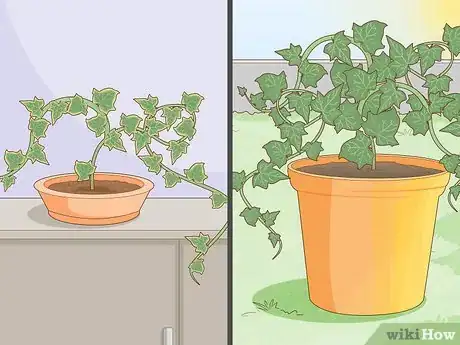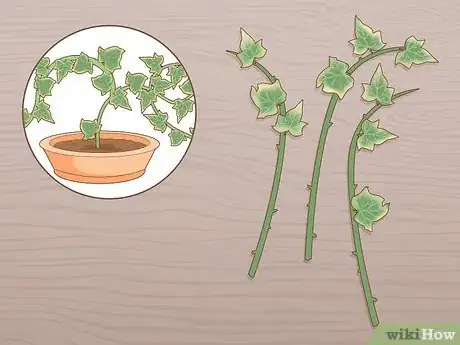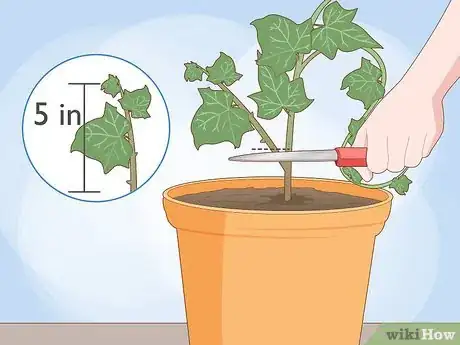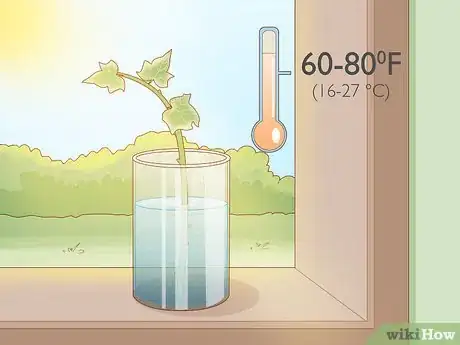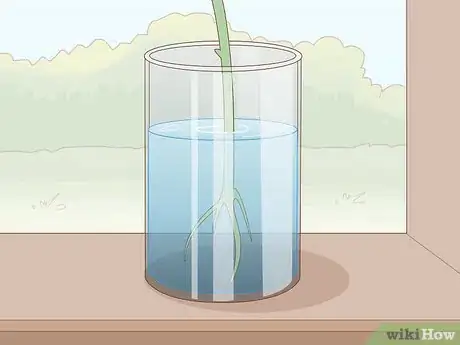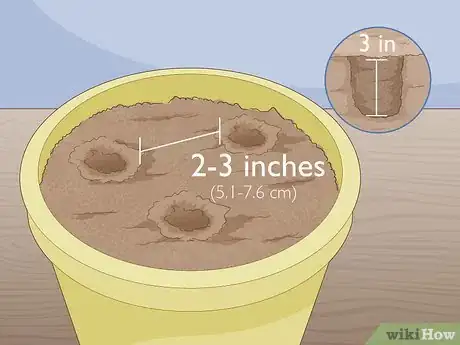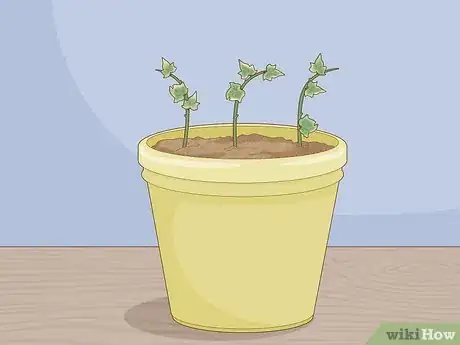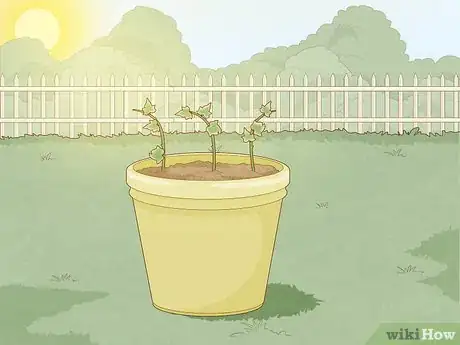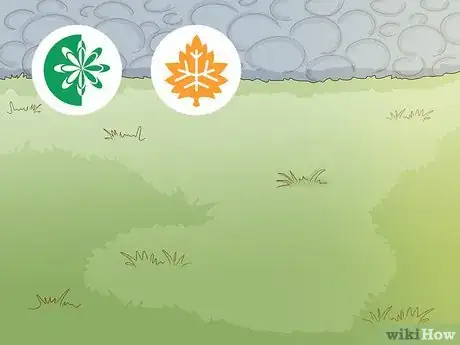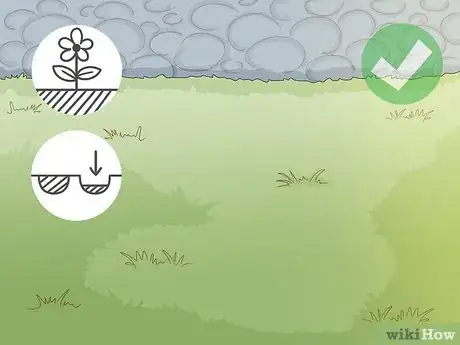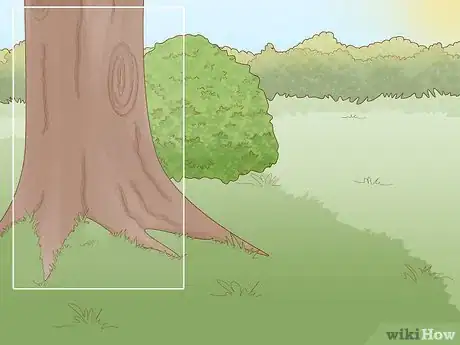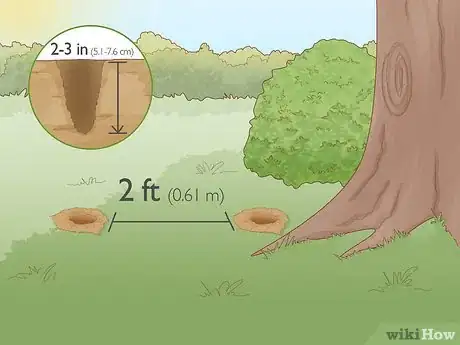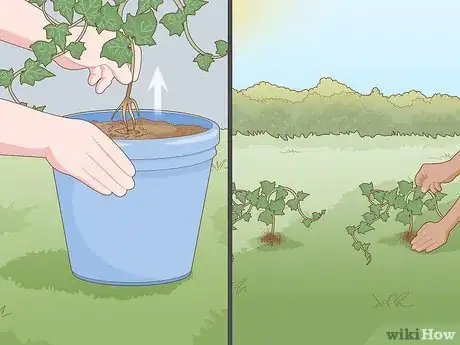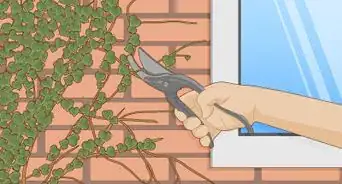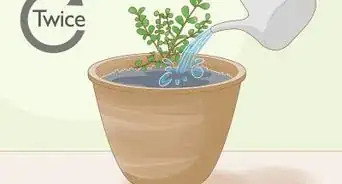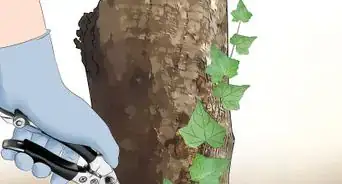This article was co-authored by Grant Wallace. Grant Wallace is a Landscaper and Owner of Grantlanta Lawn in Atlanta, Georgia. With over seven years of experience, he specializes in lawn maintenance and landscape installation. In 2012, he earned his BA from the University of West Georgia. Grant has been profiled in Shoutout Atlanta, Canvas Rebel, and Voyage ATL.
There are 8 references cited in this article, which can be found at the bottom of the page.
wikiHow marks an article as reader-approved once it receives enough positive feedback. In this case, 100% of readers who voted found the article helpful, earning it our reader-approved status.
This article has been viewed 216,070 times.
Ivy is a vine that grows quickly and comes in many varieties that can be used as a decorative indoor plant, outdoor ground cover, or to grow up a structure, wall, or tree. Ivy is also easy to plant. Take a few cuttings from an existing ivy plant and place them in a glass of water until they develop roots. You can then plant them in a flower pot to grow indoors. It’s best to plant them outside in the spring or fall and in a partially shaded location.
Steps
Starting the Ivy
-
1Choose small leaf varieties for indoors and English ivy for outdoors. If you plan to keep your ivy growing indoors to add some greenery to your living space, opt for a variety with smaller leaves. Smaller leaves mean the plant will not grow as fast and won’t take up as much space. To grow ivy around a structure or use it as ground cover outdoors, choose the English or Boston ivy plant.[1]
- Small leaf ivy varieties include the Golden Curl, Parsley Crested, and Spanish Canary.
- Make sure you know what kind of ivy you’re planting beforehand so you know what you’re getting into.
- Look up the leaves online to identify an ivy plant.
- English and Boston ivy have larger leaves and spread very quickly.
-
2Use several cuttings from an existing ivy plant if possible. Look for a section of an ivy plant that is old enough for the stem to be woody and strong, but young enough that it’s still flexible enough to bend. Take 3 or 4 cuttings to ensure at least 1 of them will develop roots and grow.[2]
- You can also purchase cuttings with well-established roots from a garden center, home improvement store, or nursery for convenience.
Variation: You can plant ivy from seed by using a packet of ivy seeds or by collecting the berries of a mature ivy plant and removing the seeds. Soak the seeds in a glass of room temperature water for 24 hours to help the seedling break out of the shell. Then, plant them about 1–2 inches (2.5–5.1 cm) deep into a container of all-purpose potting soil. After about 6 weeks, you can transplant them outdoors.[3]
Advertisement -
3Cut 5 in (13 cm) sections with a sharp knife just below a node. A node is a small bump where a leaf grows or has grown from the stem of an ivy plant. Take a sharp knife and remove a section of the ivy by cutting just below the node with as clean of a cut as possible so the stem isn’t too damaged and roots will grow.[4]
- The tip, or end of an ivy plant, is generally the best place to take a cutting from, but make sure it’s still flexible.
- You can also use a sharp pair of scissors or pruners to cut the ivy.
-
4Place the cuttings in a glass of water in a sunny location. Fill a clear glass with room temperature water about halfway. Stick all of your ivy cuttings into the glass of water and place the glass somewhere warm and sunny such as a windowsill or a kitchen counter that gets lots of sunlight.[5]
- Make sure the room temperature is between 60–80 °F (16–27 °C).
- Use a clear glass so you can see the roots when they start to form.
-
5Wait until you see roots growing before you plant the ivy. After a few days, you should see tiny white, hairlike roots sticking out of the ends of the cuttings of ivy. When you see roots forming, the ivy cuttings can be transplanted to an indoor pot or the soil outside to start growing.[6]
- Avoid moving or disturbing the cuttings so they can produce their roots.
- The ivy cuttings can survive in the glass of water for several weeks so you can plant them whenever you’re ready.
Planting the Cuttings
-
1Use a flower pot with drainage holes at the bottom. Ivy needs to be watered every so often, but if it sits in too much moisture for too long, the roots can rot and the plant can die. Choose a flower pot that allows for drainage so you don’t have to worry about overwatering your ivy.[7]
- Design a flower pot that accentuates your ivy plant and adds to the look and style of your room.
- Decorate your own flower pot to add a bit of lively flair to your ivy plant.
-
2Fill the flower pot with all-purpose potting soil. The ivy plants need a neutral soil in order for the cuttings to survive and the young plants to thrive. Use an all-purpose potting soil and pour it into the flower pot to about 1 inch (2.5 cm) from the top so the soil won’t spill or fall out of the pot.[8]
- Lightly pat the soil to compact it down a little bit.
-
3Make 3 in (7.6 cm) holes in the soil spaced out 2–3 inches (5.1–7.6 cm). Use your fingertip or a pencil and poke holes deep enough into the soil to allow the delicate roots of the cuttings to easily spread. Make 1 hole for each of the cuttings you plan to plant in the pot.[9]
- The holes should be wide enough to fit the stem of your ivy cuttings.
-
4Dip the roots into water and cutting powder. Cutting powder is a growth hormone that helps cuttings develop roots. Take your ivy cuttings, dip the root ends into some water, then dip them into cutting powder.[10]
- Check the packaging to make sure you follow the application process correctly.
- You can find cutting powder at garden supply stores and online.
Tip: If you don’t have access to cutting powder, you can plant the cuttings directly into the soil, but it may be harder for the roots to take hold.
-
5Put at least 3 ivy cuttings in the pot. For the best chances of at least 1 of the cuttings surviving and growing in your flower pot, plant at least 3 cuttings in the soil. Make sure the holes are spaced out at least 2–3 inches (5.1–7.6 cm) from each other so their roots don’t have to compete. Insert the ends of the cuttings into the holes and pat down the soil around them so they’re propped up.[11]
- You can plant as many cuttings as you want, just make sure there’s enough room between them so they can grow.
-
6Water the soil when you finish planting the cuttings. Use a watering can or a cup of water and gently pour the water over the cuttings and soil. When you see water coming from the drainage holes at the bottom of the pot, stop watering.[12]
- Be careful not to knock over or flood the cuttings out of the soil.
- Pour the water in short increments and allow it to soak through the soil before you add more.
-
7Place the ivy in bright, indirect sunlight. A sunny room or a windowsill is a great place for your ivy plant to receive enough sunlight to grow and thrive. But don’t place the ivy in a location that gets constant and direct sunlight or it could fry the fragile cuttings.[13]
- The cuttings can take up to 6 weeks for the roots to take hold and the ivy to start really growing.
- If you live in a cold location, make sure the ivy is kept warm as well.
Transplanting Ivy Outdoors
-
1Plant the ivy cuttings in the spring or the fall. Wait until your ivy cuttings have developed a strong root system and plant them outdoors in the spring or the fall to give them the best chance of survival. The heat of summer and cold of winter will make the temperature of the soil too extreme for the roots to grow and the plants to thrive.[14]
-
2Look for an area with fertile soil and good drainage. Ivy roots can rot if they sit in standing water, so look for an area where rainwater doesn’t pool or collect. If there are already plants that are thriving in the soil, then it suggests that the soil is fertile and suitable for planting ivy.[15]
- Dry patches of dirt indicate that the soil is dry and won’t be suitable for planting.
-
3Place your ivy plants in a partially shaded location. Ivy loves to grow in shaded environments and will quickly start to propagate and spread. When you’re choosing a location for your ivy plants, look for areas that aren’t exposed to direct sunlight such as under a tree or next to a building.[16]
- Some species of ivy do perfectly fine in bright sun, as well. Research the species of ivy that you’re planting to choose the best planting environment.
-
4Choose an area near a sturdy structure to encourage the ivy to climb. Ivy will spread and grow up almost anything. But over time, the weight of the plant can damage a structure or even cause it to collapse. If you want your ivy to climb, make sure you place near a trellis, tree, wall, building, or any other type of structure that is sturdy and in good condition.[17]
-
5Poke 2–3 in (5.1–7.6 cm) deep holes about 2 ft (0.61 m) apart. Use your hands, a pencil, or a stick to create 1 hole for each of the ivy cuttings you’re planting. Make sure there’s enough space between them so their roots don’t get tangled up and the plants are able to survive the transplanting.[18]
- The ivy plants will eventually grow and blend together to form 1 large group, but the cuttings need their own space to adjust to the soil.
Tip: If you’re planting ivy as a climbing vine that you want to grow up a structure, fence, or tree, make the holes about 2 feet (0.61 m) away it.
-
6Tip the pot, remove the ivy, and insert the root end into the hole. Hold the pot containing the ivy in one hand and use your other hand to hold the dirt around the ivy. Tip the pot upside down and slide the ivy and dirt out of it. Take the cutting and gently slide the roots into the hole. Push the dirt around it into place so the cutting is held propped up in the soil.[19]
- Use your hands to pat the dirt around the plant so it’s more compressed and the ivy is held securely.
-
7Water the ivy plants 2-3 times a week after you plant them. Use a watering can or a glass of water to gently pour water onto each of the plants. Add enough water to saturate the topsoil to allow the roots to grow into it. Water the newly transplanted ivy a couple of times a week to help their roots get established.[20]
- Be careful not to dump the water and knock the plants over or flood them out of their holes.
Community Q&A
-
QuestionCan I just cut off a 6 inch piece of an existing plant and re-plant it for new growth?
 Community AnswerYes, but try to make sure it's part of the stem, although you can still propagate ivy from cuttings.
Community AnswerYes, but try to make sure it's part of the stem, although you can still propagate ivy from cuttings. -
QuestionIf I pull ivy out of the ground with a good root system on it, can I transfer it into the ground somewhere else?
 Community AnswerYes. Ivies are very resilient, but only if small roots are intact; if any root has been stripped of its outer layer of tissue, it needs to be removed.
Community AnswerYes. Ivies are very resilient, but only if small roots are intact; if any root has been stripped of its outer layer of tissue, it needs to be removed. -
QuestionCan I plant ivy in the winter?
 Community AnswerDepends on where you live. If you live near the poles, then you cannot, because it is just way too cold. You can always get a greenhouse though.
Community AnswerDepends on where you live. If you live near the poles, then you cannot, because it is just way too cold. You can always get a greenhouse though.
Expert Interview

Thanks for reading our article! If you'd like to learn more about planting ivy, check out our in-depth interview with Grant Wallace.
References
- ↑ https://youtu.be/lO_ZvTvbciQ?t=24
- ↑ http://www.permanentprocrastination.com/2016/01/grow-ivy-from-cutting.html
- ↑ https://youtu.be/g6l_QWiAN90?t=48
- ↑ https://www.rhs.org.uk/advice/profile?pid=474
- ↑ http://www.permanentprocrastination.com/2016/01/grow-ivy-from-cutting.html
- ↑ http://www.permanentprocrastination.com/2016/01/grow-ivy-from-cutting.html
- ↑ https://www.rhs.org.uk/advice/profile?pid=474
- ↑ https://hgic.clemson.edu/factsheet/growing-english-ivy-indoors/
- ↑ http://www.permanentprocrastination.com/2016/01/grow-ivy-from-cutting.html
- ↑ http://www.permanentprocrastination.com/2016/01/grow-ivy-from-cutting.html
- ↑ http://www.permanentprocrastination.com/2016/01/grow-ivy-from-cutting.html
- ↑ https://www.rhs.org.uk/advice/profile?pid=474
- ↑ https://www.rhs.org.uk/advice/profile?pid=474
- ↑ https://www.gardenista.com/posts/gardening-101-ivy/
- ↑ https://www.chicagobotanic.org/plantinfo/ivy_english
- ↑ https://plants.usda.gov/plantguide/pdf/pg_glhe2.pdf
- ↑ https://www.chicagobotanic.org/plantinfo/ivy_english
- ↑ https://www.chicagobotanic.org/plantinfo/ivy_english
- ↑ http://www.permanentprocrastination.com/2016/01/grow-ivy-from-cutting.html
- ↑ https://www.chicagobotanic.org/plantinfo/ivy_english
